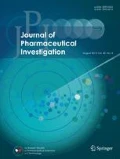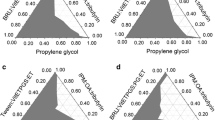Abstract
d-α-tocopheryl polyethylene glycol 1000 succinate (TPGS) is a water-soluble nonionic surfactant, which is prepared from the esterification of Vitamin E succinate with polyethylene glycol 1000. Due to unique amphiphilic structure, TPGS offers many essential properties such as solubilizer, penetration enhancer, stabilizer, emulsifier, antioxidant agent and protection of drug in micelles, which can be used for permeation of drug through skin or deposition of drug in skin. Especially, the applications of TPGS for various systems such as supersaturated system, solid lipid nanoparticles, gels, microemulsions, nanoemulsions and solid dispersions will be discussed in this review.






Similar content being viewed by others
References
Aggarwal N, Goindi S, Mehta SD (2012) Preparation and evaluation of dermal delivery system of griseofulvin containing vitamin E-TPGS as penetration enhancer. AAPS Pharm Sci Tech 13:67–74
Alonso MJ (2004) Nanomedicines for overcoming biological barriers (2004) Nanomedicines for overcoming biological barriers. Biomed Pharmacother 58:168–172
Axelsson B (1989) Liposomes as carriers for anti-inflammatory agents. Adv Drug Deliv Rev 3:391
Baek JS, Pham CV, Myung CS, Cho CW (2015) Tadalafil-loaded nanostructured lipid carriers using permeation enhancers. Int J Pharm 495:701–709
Bolzinger MA, Briancon S, Chevalier Y (2011) Nanoparticles through the skin: managing conflicting results of inorganic and organic particles in cosmetics and pharmaceutics. Wiley Interdiscip Rev Nanomed Nanobiotechnol 3:463–478
Borgheti-Cardoso LV, de Carvalho Vicentini FTM, Gratieri T, Lopes Badra Bentley MV (2016) Liquid crystalline systems containing Vitamin E TPGS for the controlled transdermal nicotine delivery. Braz. J Pharm Sci 52:191–200
Brownlow B, Nagaraj VJ, Nayel A, Joshi M, Elbayoumi T (2015) Development and in vitro evaluation of vitamin E-enriched nanoemulsion vehicles loaded with genistein for chemoprevention against UVB-induced skin damage. J Pharm Sci 104:3510–3523
Carvalho VF, de Lemos DP, Vieira CS, Migotto A, Lopes LB (2016) Potential of non-aqueous microemulsions to improve the delivery of lipophilic drugs to the skin. AAPS Pharm Sci Tech. doi:10.1208/s12249-016-0643-7
Cevc G, Blume G (1992) Lipid vesicles penetrate into intact skin owing to the transdermal osmotic gradients and hydration force. Biochim Biophys Acta 1104:226–232
Chen CH, Sheu MT, Wu AB, Lin KP, Ho HO (2005) Simultaneous effects of tocopheryl polyethylene glycol succinate (TPGS) on local hair growth promotion and systemic absorption of topically applied minoxidil in a mouse model. Int J Pharm 306:91–98
Constantinides PP, Tustian A, Kessler DR (2004) Tocol emulsions for drug solubilization and parenteral delivery. Adv Drug Deliv Rev 56:1243–1255
Crowley MM, Zhang F, Koleng JJ, McGinity JW (2002) Stability of polyethylene oxide in matrix tablets prepared by hot-melt extrusion. Biomaterials 23:4241–4248
Date AA, Desai N, Dixit R, Nagarsenker M (2010) Selfnanoemulsifying drug delivery systems: Formulation insights, applications and advances. Nanomedicine (Lond) 5:1595–1616
Davis AF, Hadgraft J (1991) Effect of supersaturation on membrane transport: 1. Hydrocortisone acetate. Int J Pharm 76:1–8
de Leeuw J, de Vijlder HC, Bjerring P, Neumann HA (2009) Liposomes in dermatology today. J Eur Acad Dermatol Venereol 23:505–516
Elsayed MM, Abdallah OY, Naggar VF, Khalafallah NM (2007) Lipid vesicles for skin delivery of drugs: reviewing three decades of research. Int J Pharm 332:1–16
Falconer JR, Wen J, Zargar-Shoshtari S, Chen JJ, Farid M, El Maghraby GM, Alany RG (2014) Evaluation of progesterone permeability from supercritical fluid processed dispersion systems. Pharm Dev Technol 19:238–246
Fischer SM, Flaten GE, Hagesæther E, Fricker G, Brandl M (2011) In-vitro permeability of poorly water soluble drugs in the phospholipid vesicle-based permeation assay: the influence of nonionic surfactants. J Pharm Pharmacol 63:1022–1030
Ghosh I, Michniak-Kohn B (2012a) A comparative study of Vitamin E TPGS/HPMC supersaturated system and other solubilizer/polymer combinations to enhance the permeability of a poorly soluble drug through the skin. Drug Dev Ind Pharm 38:1408–1416
Ghosh I, Michniak-Kohn B (2012b) Design and characterization of submicron formulation for a poorly soluble drug: the effect of Vitamin E TPGS and other solubilizers on skin permeability enhancement. Int J Pharm 434:90–98
Ghosh I, Michniak-Kohn B (2013) Influence of critical parameters of nanosuspension formulation on the permeability of a poorly soluble drug through the skin—a case study. AAPS Pharm Sci Tech 14:1108–1117
Guo Y, Luo J, Tan S, Otieno BO, Zhang Z (2013) The applications of Vitamin E TPGS in drug delivery. Eur J Pharm Sci 49:175–186
Han M, He CX, Fang QL, Yang XC, Diao YY, Xu DH, He QJ, Hu YZ, Liang WQ, Yang B, Gao JQ (2009) A novel camptothecin derivative incorporated in nano-carrier induced distinguished improvement in solubility, stability and anti-tumor activity both in vitro and in vivo. Pharm Res 26:926–935
Heather AEB, Adam CW (2012) Topical and transdermal drug delivery: principles and practice. Wiley, Hoboken
Jana P, Hommoss A, Müller RH (2009) Lipid nanoparticles (SLN, NLC) in cosmetic and pharmaceutical dermal products. Int J Pharm 366:170–184
Jenning V, Schäfer-Korting M, Gohla S (2000) Vitamin A-loaded solid lipid nanoparticles for topical use: drug release properties. J Control Release 66:115–126
Kaur L, jain SK, Singh K (2015) Vitamin E TPGS based nanogel for the skin targeting of high molecular weight anti-fungal drug: development and in vitro and in vivo assessment. RSC Adv 5:53671–53686
Khandavilli S, Panchagnula R (2007) Nanoemulsions as versatile formulations for paclitaxel delivery: peroral and dermal delivery studies in rats. J Invest Dermatol 127:154–162
Kobierski S, Ofori-Kwakye K, Müller RH, Keck CM (2009) Resveratrol nanosuspensions for dermal application—production, characterization and physical stability. Pharmazie 64:741–747
Kogan A, Garti N (2006) Microemulsions as transdermal drug delivery vehicles. Adv Colloid Interface Sci 123–126:369–385
Kydonieus AF, Berner B (1987) Transdermal Delivery of Drugs. CRC Press, Boca Raton, pp 69–77
Li S, Pollock-Dove C, Dong LC, Chen J, Creasey AA, Dai WG (2012) Enhanced bioavailability of a poorly water-soluble weakly basic compound using a combination approach of solubilization agents and precipitation inhibitors: a case study. Mol Pharm 9:1100–1108
Liou YB, Ho HO, Chen SY, Sheu MT (2009) Correlation of the penetration enhancement with the influence of an alcohol/tocopheryl polyethylene glycol succinate (TPGS) cosolvent system on the molecular structure of the stratum corneum of nude mouse skin as examined by microscopic FTIR/DSC. Spectrochim Acta Mol Biomol Spectrosc 74:695–703
Lippacher A, Müller RH, Mäder K (2001) Preparation of semisolid drug carriers for topical application based on solid lipid nanoparticles. Int J Pharm 214:9–12
Lopes LB (2014) Overcoming the cutaneous barrier with microemulsions. Pharmaceutics 6:52–77
Marwah H, Garg T, Goyal AK, Rath G (2016) Permeation enhancer strategies in transdermal drug delivery. Drug Deliv 23:564–578
Mishra PR, Shaal LA, Müller RH, Keck CM (2009) Production and characterization of Hesperetin nanosuspensions dermal delivery. Int J Pharm 371:182–189
Mohammed FA (2001) Topical permeation characteristics of diclofenac sodium from NaCMC gels in comparison with conventional gel formulations. Drug Dev Ind Pharm 27:1083–1097
Müller RH, Radtke M, Wissing SA (2002) Solid lipid nanoparticles (SLN) and nanostructured lipid carriers (NLC) in cosmetic and dermatological preparations. Adv Drug Deliv Rev 54:S131–S155
Nehilla BJ, Bergkvist M, Popat KC, Desai TA (2008) Purified and surfactant-free coenzyme Q10-loaded biodegradable nanoparticles. Int J Pharm 348:107–114
Neophytou CM, Constantinou C, Papageorgis P, Constantinou AI (2014) D-alpha-tocopheryl polyethylene glycol succinate (TPGS) induces cell cycle arrest and apoptosis selectively in Survivin-overexpressing breast cancer cells. Biochem Pharmacol 89:31–42
Paudel KS, Milewski M, Swadley CL, Brogden NK, Ghosh P, Stinchcomb AL (2010) Challenges and opportunities in dermal/transdermal delivery. Ther Deliv 1:109–131
PDR (2005) Physician’s desk reference, Medical Economics Company, Montvale, NJ, pp 1396–1401
Pham J, Brownlow B, Elbayoumi T (2013) Mitochondria-specific pro-apoptotic activity of genistein lipidic nanocarriers. Mol Pharm 10:3789–3800
Pham J, Nayel A, Hoang C, Elbayoumi T (2014) Enhanced effectiveness of tocotrienol-based nano-emulsified system for topical delivery against skin carcinomas. Drug Deliv 23:1514–1524
Rajebahadur M, Zia H, Nues A, Lee C (2006) Mechanistic study of solubility enhancement of nifedipine using vitamin E TPGS or solutol HS-15. Drug Deliv 13:201–206
Repka MA, McGinity JW (2000) Influence of vitamin E TPGS on the properties of hydrophilic films produced by hot-melt extrusion. Int J Pharm 202:63–70
Romero GB, Arntjen A, Keck CM, Müller RH (2016) Amorphous cyclosporin A nanoparticles for enhanced dermal bioavailability. Int J Pharm 498:217–224
Santos P, Watkinson AC, Hadgraft J, Lane ME (2008) Application of microemulsions in dermal and transdermal drug delivery. Skin Pharmacol Physiol 21:246–259
Sheu MT, Chen SY, Chen LC, Ho HO (2003) Influence of micelle solubilization by tocopheryl polyethylene glycol succinate (TPGS) on solubility enhancement and percutaneous penetration of estradiol. J Control Rel 88:355–368
Sheu MT, Wu AB, Lin KP, Shen CH, Ho HO (2006) Effect of tocopheryl polyethylene glycol succinate on the percutaneous penetration of minoxidil from water/ethanol/polyethylene glycol 400 solutions. Drug Dev Ind Pharm 32:595–607
Singh MD, Mital N, Kaur G (2016) Topical drug delivery systems: a patent review. Expert Opin Ther Pat 26:213–228
Somagoni J, Boakye CH, Godugu C, Patel AR, Mendonca Faria HA, Zucolotto V, Singh M (2014) Nanomiemgel–a novel drug delivery system for topical application—in vitro and in vivo evaluation. PLoS One 9:e115952
Souto EB, Wissing SA, Barbosa CM, Müller RH (2004) Development of a controlled release formulation based on SLN and NLC for topical clotrimazole delivery. Int J Pharm 278:71–77
Suppasansatorn P, Nimmannit U, Conway BR, Du L, Wang Y (2007) Microemulsions as topical delivery vehicles for the anti-melanoma prodrug, temozolomide hexyl ester (TMZA-HE). J Pharm Pharmacol 59:787–794
Sutthanut K, Lu X, Jay M, Sripanidkulchai B (2009) Solid lipid nanoparticles for topical administration of Kaempferia parviflora extracts. J Biomed Nanotechnol 5:224–232
Varma MVS., Panchagnula R (2005) Enhanced oral paclitaxel absorption with vitamin E-TPGS: effect on solubility and permeability in vitro, in situ and in vivo. Eur J Pharm Sci 25:445–453
Wissing SA, Müller RH (2002) Solid lipid nanoparticles as carrier for sunscreens: in vitro release and in vivo skin penetration. J Control Release 81:225–233
Wissing SA, Müller RH (2003) Cosmetic applications for solid lipid nanoparticles (SLN). Int J Pharm 254:65–68
Wu SH, Hopkins WK (1999) Characteristics of d-a-tocopheryl PEG1000 succinate for applications as an absorption enhancer in drug delivery systems. Pham Tech 23:52–68
Yan A, Von Dem Bussche A, Kane AB, Hurt RH (2007) Tocopheryl polyethylene glycol succinate as a safe, antioxidant surfactant for processing carbon nanotubes and fullerenes. Carbon N Y 45:2463–2470
Zhu X, Zeng X, Zhang X, Cao W, Wang Y, Chen H, Wang T, Tsai HI, Zhang R, Chang D, He S, Mei L, Shi X (2016) The effects of quercetin-loaded PLGA-TPGS nanoparticles on ultraviolet B-induced skin damages in vivo. Nanomedicine 12:623–632
Acknowledgements
This study was supported by Chungnam National University.
Author information
Authors and Affiliations
Corresponding author
Ethics declarations
Conflict of interest
All authors declare that they have no conflict of interest.
Rights and permissions
About this article
Cite this article
Pham, C.V., Cho, CW. Application of d-α-tocopheryl polyethylene glycol 1000 succinate (TPGS) in transdermal and topical drug delivery systems (TDDS). Journal of Pharmaceutical Investigation 47, 111–121 (2017). https://doi.org/10.1007/s40005-016-0300-x
Received:
Accepted:
Published:
Issue Date:
DOI: https://doi.org/10.1007/s40005-016-0300-x




